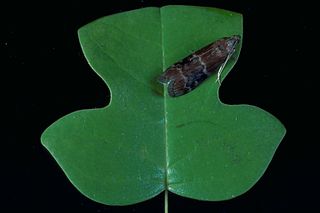
Crambidae comprises the grass moth family of lepidopterans. They are variable in appearance, with the nominal subfamily Crambinae taking up closely folded postures on grass stems where they are inconspicuous, while other subfamilies include brightly coloured and patterned insects that rest in wing-spread attitudes.

The Pyralidae, commonly called pyralid moths, snout moths or grass moths, are a family of Lepidoptera in the ditrysian superfamily Pyraloidea. In many classifications, the grass moths (Crambidae) are included in the Pyralidae as a subfamily, making the combined group one of the largest families in the Lepidoptera. The latest review by Eugene G. Munroe and Maria Alma Solis retain the Crambidae as a full family of Pyraloidea.

Waxworms are the caterpillar larvae of wax moths, which belong to the family Pyralidae. Two closely related species are commercially bred – the lesser wax moth and the greater wax moth. They belong to the tribe Galleriini in the snout moth subfamily Galleriinae. Another species whose larvae share that name is the Indian mealmoth, though this species is not available commercially.

The Pyraloidea are a moth superfamily containing about 16,000 described species worldwide, and probably at least as many more remain to be described. They are generally fairly small moths, and as such, they have been traditionally associated with the paraphyletic Microlepidoptera.

The lesser wax moth is a small moth of the snout moth family (Pyralidae) that belongs to the subfamily Galleriinae. The species was first described by Johan Christian Fabricius in 1794. Adults are about 0.5 inches (13 mm) in length and have a distinct yellow head with a silver-grey or beige body. Lesser wax moths are common in most parts of the world, except in areas with cold climates. Their geographic spread was aided by humans who inadvertently introduced them to many regions worldwide.

Aphomia sociella, also known as the bee moth and the bumble bee wax moth, is a small moth of the family Pyralidae and subfamily Galleriinae. Its body and forewings are typically reddish brown, tan, or dark green in color and females have a dark spot in the center of each forewing. The bee moth is native to Europe and are named "bee moths" because they seek out nests of bees and wasps to lay their eggs. Aphomiasociella are considered a pest because the bee moth larvae severely damage commercial bee hives. Bee moths are also studied for their unique mating ritual which includes a release of pheromones from both the male and the female along with an ultrasonic signal emitted through the male's tymbals.

Aphomia is a genus of small moths belonging to the family Pyralidae. Some breed in the nests of Anthophila, where their caterpillars are parasitic feeders of wax, honey and pollen.

Aphomia baryptera is a moth of the family Pyralidae. It is known from Australia.

Galasa nigrinodis, the boxwood leaftier moth or boxwood webworm, is moth of the family Pyralidae. It is found in eastern North America.

The Galleriinae are a subfamily of snout moths and occur essentially worldwide, in some cases aided by involuntary introduction by humans. This subfamily includes the wax moths, whose caterpillars (waxworms) are bred on a commercial scale as food for pets and as fishing bait; in the wild, these and other species of Galleriinae may also be harmful to humans as pests.

Epipaschia superatalis, the dimorphic macalla moth, is a moth in the family Pyralidae. It is found in eastern North America.

Amyelois is a monotypic snout moth genus described by Hans Georg Amsel in 1956. Its single species, Amyelois transitella, the navel orangeworm, described by Francis Walker in 1863, is endemic to the tropical Western Hemisphere, including the southern United States. Its abundance in California increased greatly during the first half of the 20th century.

Pococera robustella, the pine webworm moth, is a species of moth of the family Pyralidae. It is found in southern Canada and the eastern United States from Minnesota to New England and south to Florida.

Dioryctria albovittella, the pinyon tip moth, is a species of moth of the family Pyralidae. It is found in North America including New Mexico.

Dioryctria amatella, the southern pineconeworm moth, is a species of moth of the family Pyralidae. It is found in the south-eastern United States, from Maryland south to Florida and west into Texas.

Euzophera ostricolorella, the root collar borer moth or tuliptree borer, is a species of moth of the family Pyralidae. It was described by George Duryea Hulst in 1890. The species is found in the United States from Arkansas and Louisiana to northern Florida, north to Michigan and New York.

Aphomia monochroa is a species of snout moth in the genus Aphomia. It was described by George Hampson in 1912 and is known from Sri Lanka and India.

Aphomia sabella, the greater date moth, is a species of snout moth in the genus Aphomia. It was described by George Hampson in 1901 and is known from the Persian Gulf, Algeria and Iran. It was first recorded in Spain in 1999.
Aphomia taiwanalis is a species of moth of the family Pyralidae described by Jinshichi Shibuya in 1928. It is found in Taiwan.

Dolichovespula arenaria, also known as the common aerial yellowjacket, sandhills hornet, and common yellow hornet, is a species of wasp within the genus Dolichovespula widely distributed in the North American continent.


















